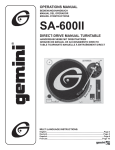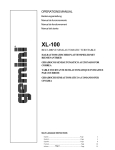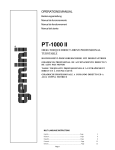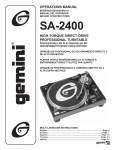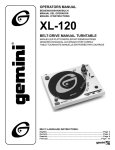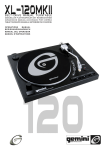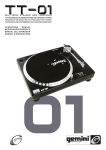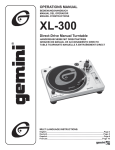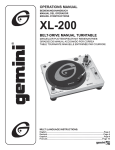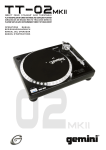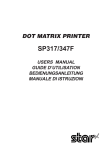Download Gemini SA-600 Turntable User Manual
Transcript
OPERATIONS MANUAL BEDIENUNGSHANDBUCH MANUAL DEL OPERADOR MANUEL D’INSTRUCTIONS SA-600 DIRECT-DRIVE MANUAL TURNTABLE HANDDREHSCHEIBE MIT DIREKTANTRIEB GIRADISCOS MANUAL DE ACCIONAMIENTO DIRECTO TABLE TOURNANTE MANUELLE À ENTRAÎNEMENT DIRECT MULTI LANGUAGE INSTRUCTIONS: English.....................................................................................................Page 4 Deutsch...................................................................................................Page 6 Español....................................................................................................Page 9 Francais.................................................................................................Page 12 Italiano....................................................................................................Page 15 Page 1 Figure 1 11 12 16 21 10 8 9 1 20 18 6 19 7 5 2 4 15 3 17 Page 2 22 23 13 14 Figure 2 Figure 3 Page 3 Introduction 4. Put the RUBBER MAT (4) on the PLATTER (2). Congratulations on purchasing a Gemini SA-600 turntable. This state of the art turntable includes the latest features. Prior to use, we suggest that you carefully read all the instructions. Features • • • • CARTRIDGE INSTALLATION: (SEE FIG. 2) Because all cartridges have their own designs, please refer to your particular cartridge’s instructions to insure proper installation. 1. Connect the lead wires to the cartridge terminals. For your convenience, the terminals of most cartridges are color coded. Connect each lead wire to the terminal of the same color. ±10% Pitch control Braking for quick stops Strobe illuminator Soft-touch start/stop switch White (L+).................................Left Channel + Blue (L-)....................................Left Channel Red (R+)................................Right Channel + Green (R-).............................Right Channel - Precautions 2. Mount the cartridge in the HEADSHELL (5) and tighten it with the screws included with the cartridge. 1. Read all operating instructions before using this equipment. 2. The apparatus should not be exposed to dripping or splashing and no objects filled with liquids such as vases should be placed on the apparatus. HEADSHELL INSTALLATION: 3. To reduce the risk of electrical shock, do not open the unit. There are NO USER REPLACEABLE PARTS INSIDE. Please contact the Gemini Service Department or your authorized dealer to speak to a qualified service technician. In the U.S.A., if you have any problems with this unit, call 1-732-969-9000 for customer service. Do not return equipment to your dealer. Insert the HEADSHELL (5) into the front of the tubular TONE ARM (6). While holding the HEADSHELL (5) firmly in a horizontal position, turn the LOCKING NUT (7) counter clockwise until the HEADSHELL (5) is locked in place. The Gemini angled headshell was designed to be used with a straight tone arm. Any type of cartridge can be mounted in the Gemini angled headshell. USING A STRAIGHT TONE ARM: 4. Tone arm bearings are factory set and sealed. Any attempt at adjustment will void the warranty. 5. Be sure that all AC power is OFF while making connections. 6. Cables should be low capacitance, shielded and of proper length. Make sure that all plugs and jacks are tight and properly connected. 7. Always begin with the audio level faders/volume controls set at minimum and the speaker volume control(s) set to OFF. Wait 8 to 10 seconds prior to turning up the speaker volume to prevent the transient “POP” that could result in speaker/crossover damage. When using a straight tone arm with a banana stylus or a cartridge mounted in a standard headshell, you should always use a conical type of needle. If you use an elliptical needle, the needle will sit in the groove of the record properly, but one channel will be louder than the other channel. The Gemini straight tone arm has been designed so that it will line up with markings on LPs you have made when using a turntable with an S-shaped tone arm. COUNTERWEIGHT INSTALLATION: (SEE FIG. 3) 1. Slide the COUNTERWEIGHT (8) onto the rear of the TONE ARM (6) with the numbered stylus gauge facing forward. 8. DO NOT EXPOSE THIS UNIT TO RAIN OR MOISTURE. 9. DO NOT USE ANY SPRAY CLEANER OR LUBRICANT ON ANY CONTROLS OR SWITCHES. 2. Twist the COUNTERWEIGHT (8) lightly counter clockwise, to screw it onto the rear of the TONE ARM (6). Parts Checklist ADJUSTING HORIZONTAL ZERO (0) BALANCE AND STYLUS PRESSURE: Turntable unit.............................................................................1 Dust cover hinge...........................................................................2 1. Without touching the stylus tip, remove the stylus protector (if your cartridge has a detachable one). Turntable platter.............................................................................1 2. Release the ARM CLAMP (9) and lift the TONE ARM (6) off the ARM REST (10). 45 RPM adapter..................................................................................1 Rubber mat......................................................................................1 3. Counter clockwise advancement of the COUNTERWEIGHT (8) will cause the cartridge side of the TONE ARM (6) to be lowered. Clockwise will cause the opposite. Turn the COUNTERWEIGHT clockwise or counter clockwise as needed until the TONE ARM is balanced horizontally. You can easily tell this by watching for the point where the TONE ARM “floats” freely. Counter balance..............................................................................1 Dust cover..........................................................................................1 Headshell..........................................................................................1 Assembly and Set-Up SEE FIG. 1 ( PAGE 1 ) FOR PART NUMBERS AND LOCATIONS. TURNTABLE INSTALLATION: 1. Set the TURNTABLE BASE (1) on a flat, level surface free of vibration. Try to place the unit as far away from the speakers as possible. Keep the unit away from direct exposure to the sun, heat, moisture or dirt. Keep the unit well ventilated. Use the turntable feet to horizontally stabilize the unit. 2. Make sure that the VOLTAGE SELECTOR (3) switch (located on the TURNTABLE BASE) is set to the correct voltage. WARNING: If you try to operate the turntable with the incorrect voltage setting, it can damage your turntable. 3. After checking to ensure that all packing materials have been removed, gently place the PLATTER (2) on the center spindle of the TURNTABLE BASE (1). 4. Place TONE ARM (6) on ARM REST (10) and lock it in place with the ARM CLAMP (9). 5. With the TONE ARM (6) locked on the ARM REST (10), hold the COUNTERWEIGHT (8) steady with one hand while rotating the STYLUS PRESSURE RING (11) until the numeral “0” on the ring aligns with the center line on the TONE ARM (6) rear shaft. The horizontal zero (0) balance should be completed. 6. Refloat the TONE ARM to ensure horizontal zero (0) balance. If zero balance has not been maintained, repeat counterweight steps 3 - 5. 7. After adjusting the horizontal zero (0) balance, turn the balanced COUNTERWEIGHT (8) counter clockwise until the cartridge manufacturer’s recommend stylus pressure appears on the STYLUS PRESSURE RING (11) where it meets the center line of the TONE ARM (6) rear shaft. Page 4 ADJUSTING THE ANTI-SKATING CONTROL: TARGET LIGHT: Set the ANTI-SKATING CONTROL (12) to the same value as the stylus pressure. 1. Push the TARGET LIGHT SWITCH (18) firmly and the TARGET LIGHT (19) will illuminate the stylus tip. 2. When not being used, the TARGET LIGHT should be turned off. INSTALLING THE DUSTCOVER: ADJUSTING THE PITCH CONTROL: 1. Mount the hinges onto the dustcover. 3. Always raise the dustcover before removal. 1. The SA-600 is equipped with a PITCH CONTROL (21). When the PITCH CONTROL is in the center position the speed will be 33 or 45 depending on which SPEED SELECTOR (15) is pushed. 4. Avoid opening and closing the dustcover during play. Undesirable vibration and stylus skipping can result. 2. When the PITCH CONTROL is positioned off center, the pitch can vary ±10% depending on the position of the PITCH CONTROL. 2. Hold the dustcover in position, directly above the turntable, and slide the hinge bases into the holders mounted on the rear panel. CONNECTIONS: 1. Plug the AC power plug into an appropriate outlet. 2. See Table A for proper connection of the output RCA plugs and ground connector. Make sure that all the plugs are firmly plugged into the appropriate jacks (phono inputs). To reduce hum, make sure the ground lug is firmly connected to the ground screw. TABLE A 3. The PLATTER (2) is equipped with a STROBE RPM INDICATOR STRIP (22) and the POWER (13) switch contains built in STROBE LIGHTS (23). When the PLATTER (2) is spinning, the STROBE LIGHTS illuminate the STROBE RPM INDICATOR STRIP. At 60 Hz the bottom row of dots will appear to be stationary when the speed of the platter is exactly 45 RPM and the second row from the bottom will appear to be stationary at 33 RPM. At 50 Hz, the second row from the top represents 45 RPM and the top row represents 33 RPM. PITCH BEND: OUTPUT CONNECTORS L (WHITE) MIXER OR RECEIVER R (RED) PHONO R CHANNEL GND (Spade Lug) GND Screw 1. Pushing the PITCH BEND (20) buttons will temporarily raise or lower the pitch without changing the slide setting. Releasing the buttons will return the pitch to the slide setting. PHONO L CHANNEL Specifications Operating Instructions TURNTABLE SECTION: Type................................................................Direct Drive Manual Turntable BASIC OPERATION: Drive Method...............................................................................Direct Drive 1. Place a record on the RUBBER MAT (4) which sits on the PLATTER (2). Motor...............................................................................Brushless DC Motor 2. Select the desired speed by depressing the 33 or 45 SPEED SELECTOR (15) button. Platter...............................................Aluminum Diecast 13” (332 mm) Dia. Speed....................................................................................33 1/3 or 45 RPM 3. Turn the POWER (13) switch to the “ON” position, at which point the strobe illuminator (built into the POWER (13) switch and the speed indicator (for the selected speed) will illuminate. Starting Torque..............................................................................1.2 Kg/cm Build-up Characteristics...................................0.8 sec. standstill to 33 1/3 RPM 4. Remove the stylus protector (if applicable to your cartridge). Braking System...................................................................Brake (Solenoid) 5. Release the ARM CLAMP (9) found on the ARM REST (10). Wow and Flutter.....................................................................0.02% WRMS* 6. Push the START STOP (14) button. The turntable PLATTER (2) will start to spin. * This rating refers to the turntable assembly and platter only and excludes effects of records, cartridges or tonearms. 7. Push the CUE LEVER (16) to the “UP” position. Rumble...............................................................................56 dB Unweighted 8. Position the tone arm over the desired position on the record and push the CUE LEVER to the “DOWN” position. The TONE ARM (6) will slowly lower onto the record at which time play will begin. TONEARM SECTION: Type.............................................................Universal Straight Tubular Arm 9. When play is over, raise the TONE ARM (6), move it to the ARM REST (10), and secure it with the ARM CLAMP (9). 10.You now have the option of turning off the power by turning the POWER (13) switch to the “OFF” position, or stopping the PLATTER (2) by pushing the START STOP (14) button and engaging the electronic brake. INTERRUPTING PLAY: 1. Pushing the CUE LEVER (16) to the “UP” position will cause the TONE ARM (6) to lift stopping play. Effective Length...............................................................9 1/16” (231.5 mm) Overhang............................................................................19/32" (15.1 mm) Effective Mass........................................................9 g (Without Cartridge) Offset Angle.............................................................................................22° Friction...................................................Less Than 7 mg (Lateral, Vertical) Tracking Error Angle................Within 2°32' at the outer groove and within 0°32' at the inner groove of a 30 cm (12") record Stylus Pressure Adjust Range.............................................................0 - 5 g Applicable Cartridge Weight Range.................................................6 - 10 g 2. Pushing the CUE LEVER (16) to the “DOWN” position will cause the TONE ARM (6) to slowly lower onto the record at the point where play was interrupted. Headshell Weight......................................................................................9 g PLAYING 45 RPM RECORDS: Power Consumption........................................................................15 Watts GENERAL: Power Supply............................................................115V~60Hz/230V~50Hz 1. When playing a 45 RPM record with a large center hole, first place the 45 ADAPTER (17) on the center spindle. 2. Be sure that the 45 SPEED SELECTOR (15) button is pushed and the 45 speed indicator is illuminated. Dimensions.....................................17 3/4” x 6" x 14" (450 x 152 x 352 mm) Weight.....................................................................................22.5 lbs. (10 kg) Specifications are subject to change without notice. The weight and dimensions shown are approximate. Page 5 Einleitung 3. Nachdem Sie überprüft haben, daß das Verpackungsmaterial vollkommen entfernt worden ist, setzen Sie den PLATTENTELLER PLATTER (2) vorsichtig auf die mittige Spindel des PLATTENSPIELERCHASSIS - TURNTABLE BASE (1). Wir gratulieren Ihnen zum Kauf eines Gemini SA-600 Plattenspielers. Dieses hochentwickelte erstklassige Gerät enthält die neuesten Leistungsmerkmale. Vor Anwendung dieses Plattenspielers bitte alle Anweisungen sorgfältig durchlesen. 4. Den GUMMITELLER - RUBBER MAT (4) auf den PLATTENTELLER PLATTER (2) legen. EINBAU DES TONABNEHMERS: (SIEHE ABBILDUNG 2) Leistungsmerkmale • ±10% Geschwindigkeitsregelung • Bremsvorrichtung für Schnellstop • Strobelicht • Start-/Stop-Funktionstaste Weil alle Tonabnehmer individuell ausgeführt sind, siehe jeweilige Anweisungen für Tonabnehmer, um richtigen Einbau sicherzustellen. 1. Die Zuleitungsdrähte an den Tonabnehmerklemmen anschließen. Um den Anschluß zu erleichtern, sind die meisten Tonabnehmerklemmen farbkodiert. Die Zuleitungsdrähte an den Klemmen der jeweiligen Farbkennzeichnung anschließen. Vorsichtsmaßnahmen Weiß (L+)..............................linker Kanal + Blau (L-).................................linker Kanal - 1. Vor Anwendung dieses Geräts bitten alle Anweisungen sorgfältig durchlesen. Rot (R+)................................rechter Kanal + 2. Das Gerät vor Tropfen und Spritzern schützen, und es dürfen keine mit Flüssigkeit gefüllte Behälter wie Vasen darauf gestellt werden. 3. Das Gerät nicht öffnen, um das Risiko elektrischen Schocks zu vermeiden. Es enthält KEINE VOM ANWENDER ERSETZBAREN TEILE. Die Wartung darf nur von ausgebildeten Servicetechnikern durchgeführt werden. Grün (R-)............................rechter Kanal 2. Den Tonabnehmer in den TONKOPF - HEADSHELL (5) einbauen und mit den dem Tonabnehmer beigefügten Schrauben befestigen. EINBAU DES TONKOPFES: 4. Die Tonarmlager sind werkseingestellt und abgedichtet. Jegliche Änderungsversuche führen zum Erlöschen der Garantie. 5. Darauf achten, daß beim Anschluß die Netzspannung abgeschaltet ist. 6. Nur kapazitätsarme, abgeschirmte Kabel vorschriftsmäßiger Länge benutzen. Darauf achten, daß alle Stecker und Buchsen fest angeschraubt und richtig angeschlossen sind. 7. Zu Beginn müssen die Überblendregler und Lautstärkeregler Ihres Verstärkers auf Minimum eingestellt und die Lautsprecherschalter in OFF-Position geschaltet sein. Vor dem Lauterstellen 8 bis 10 Sekunden warten, um den durch Einschwingung erzeugten Knalleffekt zu vermeiden, welches zu Lautsprecher- und Frequenzweichenschäden führen könnte. 8. Dieses Gerät nicht Regen oder Feuchtigkeit aussetzen. Den TONKOPF - HEADSHELL (5) in der Vorderseite des röhrenförmigen TONARMS - TONE ARM (6) einfügen. Beim Halten des TONKOPFES in horizontaler Position die SICHERUNGSMUTTER - LOCKING NUT (7) gegen den Uhrzeigersinn drehen, bis der TONKOPF einrastet. Der winkelige Gemini-Tonkopf wurde zum Gebrauch mit einem geraden Tonarm konstruiert. Jede Art von Tonabnehmer kann in den winkeligen GeminiTonkopf montiert werden. BENUTZUNG EINES GERADEN TONARMS: Bei Benutzung eines geraden Tonarms mit einer in einem Standardtonkopf installierten Abtastnadel oder einem kompletten Bananen-System sollten Sie immer eine sphärische Nadel benutzen. Wenn Sie eine elliptische Nadel benutzen, wird die Nadel zwar in der Plattenrille sitzen, jedoch wird ein Kanal lauter sein als der andere. Der gerade Gemini-Tonarm wurde so konstruiert, damit er mit den Markierungen fluchtet, die Sie bei Benutzung eines S-förmigen Tonarms auf den LPs gemacht haben. 9. An den Reglern oder Schaltern keine Spray-Reinigungsmittel oder Schmiermittel benutzen. Teile-Lieferumfang EINBAU DES BALANCEGEWICHTS: (SIEHE ABBILDUNG 3) 1. Das BALANCEGEWICHT - COUNTERWEIGHT (8) auf den hinteren Teil des TONARMS - TONE ARM (6) Schieben, wobei die numerierte Ringskala nach vorne gerichtet sein muß. Plattenspieler.....................................................................................1 Plattenteller....................................................................................1 Gummiteller....................................................................................1 2. Das BALANCEGEWICHT - COUNTERWEIGHT (8) gering im Gegenuhrzeigersinn ziehen, um es auf den hinteren Teil des TONARMS - TONE ARM (6) zu schrauben. Abdeckhaube.................................................................................1 Abdeckhaubenscharnier.................................................................2 45-U/min-Adapter..........................................................................1 HORIZONTALER NULLPUNKTABGLEICH UND REGULIERUNG DES AUFLAGEDRUCKS: Balancegewicht..............................................................................1 Tonkopf..........................................................................................1 1. Ohne die Nadelspitze zu berühren, entfernen Sie den Nadelschutz (falls Ihr Tonabnehmer einen abnehmbaren Nadelschutz hat). Zusammenbau und Anordnung 2. Die TONARM-KLEMMSCHELLE - ARM CLAMP (9) freigeben und den TONARMS - TONE ARM (6) von der TONARMAUFLAGE - ARM REST (10) abheben. SIEHE ABBILDUNG 1 (SEITE 1) FüR TEILENUMMERN UND POSITIONEN. EINBAU DES PLATTENSPIELERS: 1. Setzen Sie das PLATTENSPIELERCHASSIS - TURNTABLE BASE (1) auf eine flache, ebene Fläche ohne Vibration. Das Gerät so weit wie möglich von den Lautsprechern entfernt aufstellen. Das Gerät von direktem Sonnenlicht, Wärme, Feuchtigkeit oder Schmutz fernhalten. Das Gerät in gut belüfteter Umgebung aufstellen. Es mit den Plattentellerfüssen horizontal lagefest machen. 2. Den SPANNUNGSWÄHLER - VOLTAGE SELECTOR (3) (befindet sich auf dem PLATTENSPIELERCHASSIS) auf die richtige Spannung überprüfen. WARNUNG: Schalten Sie den PLATTENSPIELER mit einer falschen Spannung (115 Volt) ein, kann der Plattenspieler beschädigt werden. 3. Durch das Verdrehen gegen den Uhrzeigersinn des BALANCEGEWICHTS - COUNTERWEIGHT (8) wird die Tonabnehmerseite des TONARMS - TONE ARM (6) gesenkt. Beim Drehen im Uhrzeigersinn geschieht das Gegenteil. Das BALANCEGEWICHT je nach Bedarf im oder gegen den Uhrzeigersinn drehen, bis der TONARM horizontal ausbalanciert ist. Dies lässt sich leicht feststellen, indem man die Stelle beobachtet, wo der TONARM unbehindert “schwimmt”. 4. Den TONARMS - TONE ARM (6) auf die TONARMAUFLAGE - ARM REST (10) setzen und ihn mit der TONARM-KLEMMSCHELLE - ARM CLAMP (9) festklemmen. Page 6 5. Indem der TONARMS - TONE ARM (6) auf der TONARMAUFLAGE ARM REST (10) festgeklemmt ist, halten Sie das BALANCEGEWICHT - COUNTERWEIGHT (8) ruhig mit der Hand, während Sie den AUFLAGEDRUCKRING - STYLUS PRESSURE RING (11) rotieren, bis sich die Ziffer "0" auf dem Ring mit der Mittellinie an der Hinterwelle des TONARMS ausrichtet. Der horizontale Nullpunktabgleich (0) ist nun abgeschlossen. 8. Den Tonarm über die gewünschte Rille auf der Platte positionieren, und den CUEING-HEBEL in die “DOWN”-Position schieben. Der TONARMS - TONE ARM (6) wird sich langsam auf die Platte senken, woraufhin die Platte zu spielen beginnt. 6. Den TONARM erneut schwimmen lassen, um sicherzustellen, daß der horizontale Nullpunktabgleich (0) beibehalten wird. Wird er nicht beibehalten, wiederholen Sie Schritte 3 - 5. 10.Nun haben Sie die Option, den Strom abzuschalten, indem Sie den NETZSCHALTER - POWER (13) in die “OFF”-Position schalten, oder den PLATTENTELLER - PLATTER (2) zu stoppen, indem Sie die START STOP (14) taste drücken und die elektronische Bremse aktivieren. 7. Nach dem horizontalen NULLPUNKTABGLEICH das abgeglichene BALANCEGEWICHT - COUNTERWEIGHT (8) gegen den Uhrzeigersinn drehen, bis der vom Tonabnehmerhersteller empfohlene Auflagedruck auf dem AUFLAGEDRUCKRING - STYLUS PRESSURE RING (11) erscheint, wo er mit der Mittellinie des TONARMS - TONE ARM (6) zusammentrifft. 9. Bei Beendigung des Spielens heben Sie den TONARMS - TONE ARM (6), schieben ihn auf die TONARMAUFLAGE - ARM REST (10) und befestigen ihn mit der TONARM-KLEMMSCHELLE - ARM CLAMP (9). SPIELUNTERBRECHUNG: REGULIERUNG DER ANTISKATING-VORRICHTUNG: 1. Durch das Schieben den CUEING-HEBEL - CUE LEVER (16) in die “UP”-Position wird der TONARMS - TONE ARM (6) angehoben und unterbricht das Spielen. Die ANTISKATING-VORRICHTUNG - ANTI-SKATING CONTROL (12) auf den gleichen Wert wie den Auflagedruck einstellen. 2. Das Schieben den CUEING-HEBEL - CUE LEVER (16) in die “DOWN”Position wird den TONARMS - TONE ARM (6) langsam an der Stelle auf die Platte setzen, wo das Spielen unterbrochen wurde. EINBAU DER ABDECKHAUBE: DAS SPIELEN VON 45-U/MIN-PLATTEN: 1. Die Scharniere an der Schutzhülle anbringen. 1. Wenn Sie eine 45-U/min-Platte spielen, die ein groß Mittelloch hat, setzen Sie zunächst einen 45 ADAPTER (17) auf die Spindel. 2. Halten Sie die Abdeckhaube direkt über dem Plattenteller in Position und schieben die Scharniersockel in die Halterungen, die in die Rückwand montiert sind. 2. Darauf achten, da die 45-U/min-DREHZAHLTASTE - SPEED SELECTOR (15) gedrückt ist und die 45-U/min-drehzahlanzeige aufleuchtet. 3. Vor dem Entfernen immer die Abdeckhaube anheben. 4. Es sollte vermieden werden, die Abdeckhaube während des Spielens zu öffnen und zu schließen. Dies könnte zu unerwünschten Vibrationen und Nadelspringen führen. ANSCHLÜSSE: 2. Siehe Tabelle A für vorschriftsmäßige Anschlüsse der Ausgangs-RCAStecker und des Erdungssteckers. Achten Sie darauf, da alle Stecker an den richtigen Buchsen fest angeschlossen sind (Phono-Eingänge). Um Brummtöne zu vermeiden, ist darauf zu achten, da die Erdungsöse fest an der Erdungsschraube angeschlossen ist. TABELLE A MIXER ODER RECEIVER L ( WEIß) PHONO- L KANAL R (ROT) PHONO- R KANAL ERDUNG (Flachöse) Erdungsschraube 1. Fest auf den LAMPENSCHALTER - TARGET LIGHT SWITCH (18) drücken und die NADELBELEUCHTUNG - TARGET LIGHT (19) wird die Nadelspitze beleuchten. 2. Bei Nichtgebrauch sollte die NADELBELEUCHTUNG ausgeschaltet werden. 1. Den Netzstecker an einer entsprechenden Steckdose anschließen. AUSGANGSANSCHLUSS NADELBELEUCHTUNG: REGULIERUNG DER GESCHWINDIGKEIT: 1. Der SA-600 ist mit einem GESCHWINDIGKEITSREGLER - PITCH CONTROL (21) ausgerüstet. Wenn der GESCHWINDIGKEITSREGLER in Mittenposition steht, liegt die Drehzahl in der Nähe von 33 oder 45 U/min, je nachdem welche DREHZAHLTASTE - SPEED SELECTOR (15) gedrückt wird. 2. Wenn der GESCHWINDIGKEITSREGLER - PITCH CONTROL (21) auerhalb der Mittenposition steht, kann die Drehzahl zwischen +/- 10% schwanken, abhängig von der Position des GESCHWINDIGKEITSREGLER. 3. Der PLATTENTELLER - PLATTER (2) ist mit einem STROBELICHT-U/ MIN-ANZEIGESTREIFEN - STROBE RPM INDICATOR STRIP (22) ausgerüstet, und der NETZSCHALTER - POWER (13) enthält eingebaute STROBELICHTER - STROBE LIGHTS (23). Wenn sich der PLATTENTELLER - PLATTER (2) dreht, erleuchten die STROBELICHTER den STROBELICHT-U/MIN-ANZEIGESTREIFEN. Die untere Punktereihe wird feststehend erscheinen, wenn die Drehzahl genau 45 U/min ist. Die zweite Reihe von unten wird bei einer Drehzahl von 33 U/min feststehend erscheinen. Bedienungsanweisungen GRUNDBETRIEB: 1. Die Platte auf den GUMMITELLER - RUBBER MAT (4) legen, die auf dem PLATTENTELLER - PLATTER (2) sitzt. 2. Die gewünschte Drehzahl auswählen, indem Sie an der DREHZAHLTASTE - SPEED SELECTOR (15) entweder 33 oder 45 auswählen. PITCH BEND-TASTEN: 1. Wenn die PITCH BEND (20) Tasten (kurzzeitige Geschwindigkeitsänderung) gedrückt werden, wird die Geschwindigkeit automatisch angehoben oder gesenkt, ohne die Schiebeeinstellung zu verändern. Wenn die Tasten freigegeben werden, kehrt die Geschwindigkeit zur Schiebereinstellung zurück. Sie können diese Funktion benutzen, um die Geschwindigkeit beim Mischen von einem Song zum anderen anzupassen. 3. Den LEISTUNGSSCHALTER - POWER (13) in die “ON”-Position schalten, woraufhin das (in den LEISTUNGSSCHALTER eingebaute) Strobelicht und die drehzahlanzeige (für die ausgewählte Drehzahl) aufleuchten wird. 4. Den Nadelschutz abnehmen (falls an Ihrem Tonabnehmer vorhanden). 5. Die TONARM-KLEMMSCHELLE - ARM CLAMP (9) an der TONARMAUFLAGE - ARM REST (10) freigeben. 6. Die START STOP-TASTE - START STOP (14) drücken. Der PLATTENTELLER - PLATTER (2) wird anfangen zu drehen. 7. Den CUEING-HEBEL - CUE LEVER (16) in die “UP”-Position schieben. Page 7 Spezifikationen Typ...........................................................................Manueller Plattenspieler Antriebsmethode...........................................................................Direktantrieb Motor............................................................Bürstenloser Gleichstrommotor Plattenteller................................................Druckguß, 332 mm Durchmesser Drehzahl..........................................................................33 1/3 oder 45 U/min Anlaufmoment..................................................................................1,2 Kg/cm Hochlauf- & Bremsdaten..................0,8 sec. Stillstand bis 33 1/3 U/min Bremssystem..................................................................Bremse (Solenoid) Gleichlaufschwankungen.......................................................0,02% WRMS* * Dieser Nennwert bezieht sich nur auf das Laufwerk inklusive Plattenteller, ausschießlich Auswirkungen der Platten, Tonabnehmer oder Tonarme Rumpeln.....................................................................56 dB Fremdspannung TONARM: Typ..................................................Gerader röhrenförmiger Universaltonarm Nutzlänge..........................................................................231,5 mm (9 1/16”) Überhang.............................................................................15,1 mm (19/32") Effektive Masse........................................................9 g (ohne Tonabnehmer) Reibungswinkel............................................................................................22° Reibung......................................................Wenige als 7 mg (seitlich, vertikal) Abtastfehlerwinkel.............Innerhalb 2°32‘ an der Außenrille und innerhalb von 0°32" an der Innenrille einer 30-cm-Platte Auflagedruck-Einstellbereich................................................................0 - 5 g Anwendbarer Tonabnehmer-Gewichtsbereich.................................6 - 10 g Tonkopfgewicht........................................................................................9 g ALLGEMEINES: Stromversorgung.....................................................115V~60Hz/230V~50Hz Stromverbrauch....................................................................................15 W Abmessungen...............................................................450 x 152 x 352 mm Gewicht.................................................................................................10 kg Spezifikationen können ohne vorherige Anmeldung geändert werden. Gewichtsangaben und Abmessungen sind annähernd. Page 8 Introducción 3. Después de comprobar que se hayan quitado todos los materiales de embalaje, coloque el PLATO - PLATTER (2) suavemente en el huso central de la BASE DEL TOCADISCO - TURNTABLE BASE (1). Felicitaciones por su compra de un tocadiscos Gemini SA-600. Este tocadiscos de la más avanzada tecnología está dotado de características ultramodernas. Antes de usarlo, le recomendamos leer cuidadosamente todas las instrucciones. 4. Coloque la ESTERA DE GOMA - RUBBER MAT (4) sobre el PLATO PLATTER (2). INSTALACIÓN DEL CARTUCHO: (VÉASE LA FIG. 2) Características • • • • Debido a que todos los cartuchos son de diseño distinto, sírvase referirse a las instrucciones de su cartucho específico, para garantizar la instalación correcta. Regulación del tono de ±10% Frenado para paradas rápidas Iluminador estroboscópico Interruptor táctil de arranque/parada 1. Conecte los cables conductores a los terminales del cartucho. Para su conveniencia, los terminales de la mayoría de los cartuchos están codificados por colores. Conecte cada cable conductor al terminal del mismo color. Precauciones Blanco (I+).....................Canal izquierdo + Azul (I-).........................Canal izquierdo - 1. Deberán leerse todas las instrucciones de operación antes de usar el equipo. Rojo (D+)......................Canal derecho + 2. Este aparato no debería estar expuesto al goteo o a las salpicaduras y ningun objeto llenado de líquido, tal como floreros, no debería estar colocado sobre del aparato. Verde (D-).....................Canal derecho 2. Monte el cartucho dentro del PORTACÁPSULAS - HEADSHELL (5) y apriételo con los tornillos incluidos con el cartucho. 3. Para reducir el riesgo de shock eléctrico, no abra la unidad. NO CONTIENE PIEZAS REEMPLAZABLES POR EL USUARIO. Sírvase comunicarse con el Departamento de Servicio Gemini o su distribuidor autorizado y hablar con un técnico de servicio calificado. INSTALACIÓN DEL PORTACÁPSULAS: 4. Los cojinetes del brazo de fonocaptor están ajustados y sellados en fábrica. Cualquier intento de ajuste dejará sin efecto la garantía. 5. Cerciórese de que toda la corriente CA esté APAGADA para efectuar las conexiones. 6. Los cables deberán ser de baja capacidad, reguardados, y de apropiada longitud. Cerciórese de que todos los enchufes y jacks estén apretados y debidamente conectados. Inserte el PORTACÁPSULAS - HEADSHELL (5) en la parte delantera del BRAZO DE FONOCAPTOR - TONE ARM (6) tubular. Sosteniendo el PORTACÁPSULAS firmemente en posición horizontal, gire la TUERCA FIADORA - LOCKING NUT (7) hacia la izquierda hasta que el PORTACÁPSULAS se haya asegurado en posición. El portacápsulas angular de Gemini fue diseñado para el uso con el brazo de fonocaptor recto. Es posible instalar cualquier tipo de cartucho en el portacápsulas angular de Gemini. USO DEL BRAZO DE FONOCAPTOR RECTO: 7. Comience siempre con los atenuadores de nivel de audio/control de volumen fijados en el nivel mínimo y el control de volumen de los altavoces fijados en APAGADO. Espere 8 a 10 segundos antes de aumentar el volumen de los altavoces para evitar el “chasquido” transitorio que podría ocasionar daños a los altavoces/de cruce. Cuando se usa el brazo de fonocaptor recto con aguja tipo banana o un cartucho montado en un portacápsulas estándar, siempre se debería utilizar agujas del tipo cónico. Si se usa aguja elíptica, la aguja se posicionará correctamente en la ranura del disco pero un canal será más fuerte que el otro. 8. No deje esta unidad expuesta a lluvia o humedad. 9. No use ningun limpiador de rocío o lubricante en cuaquiera de los controles o interruptores. El brazo de fonocaptor recto de Gemini ha sido diseñado para que se alinee con las marcaciones en los discos LP cuando se usa un giradiscos con brazo de fonocaptor en forma de S. Lista de comprobación de piezas INSTALACIÓN DEL CONTRAPESO: (VÉASE LA FIG. 3) Unidad de tocadisco.......................................................................1 Plato del tocadisco.........................................................................1 Estera de goma.............................................................................1 Tapa contra polvo..........................................................................1 Bisagra de tapa contra polvo..........................................................2 Adaptador de 45 RPM......................................................................1 Contrapeso...................................................................................1 Portafonocaptor...............................................................................1 1. Deslice el CONTRAPESO - COUNTERWEIGHT (8) sobre la parte posterior del BRAZO DE FONOCAPTOR - TONE ARM (6) con la medida de la aguja numerada hacia el frente. 2. Gire el CONTRAPESO - COUNTERWEIGHT (8) ligeramente hacia la izquierda para enroscarlo en la parte posterior del BRAZO DE FONOCAPTOR - TONE ARM (6). AJUSTE DEL EQUILIBRIO CERO (0) HORIZONTAL Y PRESIÓN DE LA AGUJA: Montaje y configuración 1. Sin tocar la punta de la aguja, quite el protector de aguja (si el de su cartucho es reemplazable). NOTA: VÉASE LA FIG. 1 (PÁGINA 1) PARA NÚMEROS DE PIEZA Y UBICACIONES. 2. Suelte el SUJETABRAZO - ARM CLAMP (9) y levante el BRAZO DE FONOCAPTOR - TONE ARM (6) del DESCANSILLO - ARM REST (10). INSTALACIÓN DEL TOCADISCO: 1. Ponga la BASE DEL TOCADISCO - TURNTABLE BASE (1) sobre una superficie plana y nivelada sin vibraciones. Trate de colocar la unidad lo mas alejado posible de los altavoces. Mantenga la unidad alejada de la exposición directa del Sol, calor, humedad o suciedad. Mantenga la unidad bien ventilada. Use la patas del tocadisco para estabilizar la unidad en sentido horizontal. 2. Cerciórese de que el SELECTOR DE VOLTAJE - VOLTAGE SELECTOR (3) (colocado en la BASE DEL TOCADISCO) esté ajustado para el voltaje correcto. ADVERTENCIA: Si trata de hacer funcionar el tocadisco con el voltaje incorrecto, corre el riesgo de dañarlo. 3. Si el CONTRAPESO - COUNTERWEIGHT (8) se avanza hacia la izquierda, se bajará el lado del cartucho del BRAZO DE FONOCAPTOR - TONE ARM (6). Si el CONTRAPESO se avanza hacia la derecha ocurrirá lo contrario. Gire el CONTRAPESO hacia la derecha o la izquierda según sea necesario hasta que el BRAZO DE FONOCAPTOR esté horizontalmente equilibrado. Ese equilibrio es fácil de determinar; espere el punto en que el BRAZO DE FONOCAPTOR “flote” libremente. 4. Coloque el BRAZO DE FONOCAPTOR - TONE ARM (6) sobre el DESCANSILLO - ARM REST (10) y asegurelo en posición con el SUJETABRAZO - ARM CLAMP (9). Page 9 5. Con el BRAZO DE FONOCAPTOR - TONE ARM (6) enganchado en el DESCANSILLO - ARM REST (10), sostenga el CONTRAPESO COUNTERWEIGHT (8) en una mano y gire el ANILLO DE PRESIÓN DEL ESTILETE - STYLUS PRESSURE RING (11) hasta que el número “0” en el anillo se alinee con la línea central del eje trasero del BRAZO DE FONOCAPTOR. El equilibrio horizontal en cero (0) deberá quedar completo. 8. Sitúe el brazo de fonocaptor arriba del surco deseado en el disco y ponga la PALANCA DE INDICACION en la posición de “ABAJO”. El BRAZO DE FONOCAPTOR - TONE ARM (6) se bajará lentamente sobre el disco en cuyo momento empezará a reproducir. 6. Flote de nuevo el BRAZO FONOCAPTOR para asegurarse que se haya obtenido el equilibro horizontal en cero (0). Si no se ha mantenido este equilibrio, repita los pasos de contrapeso 3 al 5. 10.Ahora tiene la opción de apagar la unidad, pasando el ALIMENTACIÓN - POWER (13) a la posición de “APAGADO” o de detener el PLATO PLATTER (2), oprimiendo el BOTÓN DE ARRANQUE/PARADA START STOP (14) y enganchando el freno electrónico. 7. Después de ajustar el equilibrio cero (0) horizontal, gire el CONTRAPESO - COUNTERWEIGHT (8) equilibrado hacia la izquierda hasta que aparezca en el ARO DE PRESIÓN DE AGUJA - STYLUS PRESSURE RING (11) la presión de aguja recomendada del fabricante del cartucho en el punto donde coincide con la línea central del eje posterior del BRAZO DE FONOCAPTOR - TONE ARM (6). AJUSTE DEL CONTROL ANTIDESLIZANTE: 9. Una vez que haya terminado de reproducir, levante el BRAZO DE FONOCAPTOR - TONE ARM (6), MUEVALO hacia el DESCANSILLO ARM REST (10) y fíjelo con el SUJETABRAZO - ARM CLAMP (9). INTERRUPCIÓN DE LA REPRODUCCIÓN: 1. Oprimiendo la PALANCA DE INDICACION - CUE LEVER (16) a la posición de “ARRIBA”, causara que el BRAZO DE FONOCAPTOR TONE ARM (6) se levantará y se detengá la reproducción. Fije el CONTROL ANTIDESLIZANTE - ANTI-SKATING CONTROL (12) al mismo valor que la presión de la aguja. 2. Oprimiendo la PALANCA DE INDICACION - CUE LEVER (16) a la posición de “ABAJO” causara que el BRAZO DE FONOCAPTOR TONE ARM (6) se baje lentamente sobre el disco en el lugar donde se interrumpió la reproducción. INSTALACIÓN DE LA TAPA CONTRA POLVOS: REPRODUCCIÓN DE DISCOS DE 45 RPM: 1. Instale las bisagras en la cubierta. 1. Para reproducir un disco de 45 RPM con un agujero central más grande, ponga primero el ADAPTADOR DE 45 - 45 ADAPTER (17) en el huso central. 2. Sostenga la tapa contra polvos en posición directamente arriba del tocadisco y deslice las bases de las bisagras en los portabisagras montados en el panel posterior. 2. Cerciórese de que se haya oprimido el BOTÓN SELECTOR DE VELOCIDAD - SPEED SELECTOR (15) 45 y que esté iluminado el indicador de velocidad 45. 3. Siempre levante la tapa contra polvos antes de quitarla. 4. Evite abrir y cerrar la tapa contra polvos cuando el tocadisco está en funcionamiento, ya que podría ocurrir vibración indeseable y saltos de la aguja. LUZ DE POSICIÓN: 1. Oprima firmemente el INTERRUPTOR DE LUZ DE POSICIÓN TARGET LIGHT SWITCH (18) y la LUZ DE POSICIÓN - TARGET LIGHT (19) iluminará la punta de la aguja. CONEXIONES: 1. Conecte el enchufe CA en una toma de corriente apropiada. 2. Véase el Cuadro A para las conexiones apropiadas de los enchufes de salida RCA y el conector a tierra. Cerciórese de que todos los enchufes estén firmemente conectados en los jack apropiados (entradas fonográficas). Para reducir el zumbido, cerciórese de que la toma de tierra esté firmemente conectada al tornillo de tierra. CUADRO A CONECTORES DE SALIDA MEZCLADOR O RECEPTOR I (BLANCO) I CANAL DEL FONÓGRAFO D (ROJO) D CANAL DEL FONÓGRAFO TIERRA (Orejeta de paleta) 1. El equipo SA-600 está dotado de un CONTROL DE TONO - PITCH CONTROL (21). Cuando el CONTROL DE TONO se encuentra en la posición central, la velocidad será cercana a 33 ó 45, según el BOTÓN SELECTOR DE VELOCIDAD - SPEED SELECTOR (15) que se haya oprimido. 3. El PLATO - PLATTER (2) está dotado de una TIRA INDICADORA DE RPM ESTROBOSCÓPICA - STROBE RPM INDICATOR STRIP (22) y el INTERRUPTOR DE ENERGÍA - POWER (13) contiene LUCES ESTROBOSCÓPICAS - STROBE LIGHTS (23) incorporadas. Cuando el PLATO - PLATTER (2) gira, las LUCES ESTROBOSCÓPICAS (22) iluminan la TIRA INDICADORA DE RPM ESTROBOSCÓPICA. La fila inferior de puntos parecerá estar estacionaria cuando la velocidad del plato sea exactamente 45 RPM. La segunda fila del fondo parecerá estar estacionaria a 33 RPM. Instrucciones de operación OPERACIÓN BÁSICA: 1. Ponga un disco sobre la ESTERA DE GOMA - RUBBER MAT (4) que descansa sobre el PLATO - PLATTER (2). 2. Seleccione la velocidad deseada, oprimiendo el BOTÓN SELECTOR DE VELOCIDAD - SPEED SELECTOR (15) de 33 ó 45. 3. Ponga el ALIMENTACIÓN - POWER (13) en la posición de “ENCENDIDO”, en cuyo momento se encenderán el iluminador estroboscópico (incorporado en el ALIMENTACIÓN - POWER (13) y el indicador de velocidad (para la velocidad seleccionada). 5. Suelte el SUJETABRAZO - ARM CLAMP (9) que se encuentra en el DESCANSILLO - ARM REST (10). AJUSTE DEL CONTROL DE TONO: 2. Cuando el CONTROL DE TONO - PITCH CONTROL (21) está en una posición descentrada, el paso podrá variar en ±10%, según la posición del CONTROL DE TONO. Tornillo de TIERRA 4. Quite el protector de aguja (si se aplica a su cartucho). 2. Cuando no esté en uso, se debería apagar la LUZ DE POSICIÓN. PITCH BEND BUTTONS (BOTONES DE AFINACIÓN DEL TONO): 1. El hecho de apretar los botones PITCH BEND (20) alza o baja automáticamente el tono sin cambiar la posición de la llave corrediza. Soltando los botones, se vuelve el tono a la graduación de la llave corrediza. Se puede utilizar esta función para igualar la afinación del tono cuando se mezclan canciones. 6. Oprima el BOTÓN DE ARRANQUE/PARADA - START STOP (14). El PLATO - PLATTER (2) del tocadisco empezará a girar. 7. Oprima la PALANCA DE INDICACION - CUE LEVER (16) en la posición de “ARRIBA”. Page 10 Especificaciones SECCIÓN DE TOCADISCO: Tipo.................................................Tocadisco manual de transmisión directa Método de transmisión..................................................Transmisión directa Motor..............................................................................Motor sin escobillas Plato............................Troquelado de aluminio, 13p” (332mm) de diám. Velocidad...........................................................................33 1/3 or 45 RPM Par motor de arranque....................................................................1,2 Kg/cm Características de cebado.....................0.8 sec. standstill to 33 1/3 RPM Sistema de frenado........................................Freno electrónico (solenoide) Gimoteo y tremolación...........................................................0.02% WRMS* *Este valor se refiere al conjunto de tocadisco y plato solamente, y excluye los efectos de los discos, cartuchos o brazos de fonocaptor. Rumor sordo.............................................................56 dB no ponderado SECCIÓN DE BRAZO DE FONOCAPTOR: Tipo...............................................................Brazo tubular recto universal Largo efectivo.................................................................9 1/16' (231.5 mm) Gama de ajuste de altura del brazo...............................................0 - 6 mm Proyección..........................................................................19/32" (15.1 mm) Masa efectiva...................................................................9 g (Sin cartucho) Ángulo del fonocaptor..............................................................................22° Fricción.....................................................Menos de 7 mg (lateral, vertical) Ángulo de error de seguimiento...........Dentro de 232" en el surco exterior y dentro de 032" en el surco interior de un disco de 30 cm (12") Gama de ajuste de presión de la aguja.......................................0 - 5 g Gama aplicable de peso de cartucho...............................................6 - 10 g Peso del portafonocaptor.........................................................................9 g GENERALIDADES: Fuente de alimentación............................................115V~60Hz/230V~50Hz Consumo de energía......................................................................15 vatios Dimensiones.................................................................450 x 152 x 352 mm Peso.......................................................................................................10 kg Las especificaciones están sujetas a cambio sin previo aviso. El peso y las dimensiones indicados son aproximaciones. Page 11 Introduction Nos félicitations à l’occasion de votre achat cette table-tournante Gemini SA-600. Ce table-tournante très moderne inclut les caractéristiques technologiques les plus récentes. Avant de l’employer, lisez attentivement toutes les instructions. Caractéristiques • • • • 2. Assurez-vous que le SELECTEUR DE LA TENSION - VOLTAGE SELECTOR (3) (situé sur la PLATINE VINYLE) soit correctement règlé. AVERTISSEMENT: Si vous essayez de faire fonctionner la platine vinyle avec une tension incorrecte, vous risquez de l’endommager. 3. Après avoir retiré tout l’emballage, positionnez soignneusement le PLATEAU DE LECTURE - PLATTER (2) sur l’axe central de la PLATINE VINYLE - TURNTABLE BASE (1). 4. Placez la FEUTRINE EN CAOUTCHOUC - NEOPRENE MAT (4) sur le PLATEAU DE LECTURE - PLATTER (2). Réglage de vitesse +/- 10% Freinage pour arrêts rapides Source lumineuse stroboscopique Commutateur marche/arrêt INSTALLATION DE LA CARTOUCHE: (VOIR LA FIGURE 2) Etant donné que toutes les cartouches ont leurs propres particularités, consultez les instructions de votre cartouche pour vous assurer d’une bonne installation. Précautions 1. Branchez les fils aux bornes de la cartouche. Pour vous faciliter la tâche, les bornes de la plupart des cartouches sont codées par couleurs. Branchez chaque fil à la borne de la même couleur. 1. Toutes les instructions de fonctionnement doivent être lues avant de vous servir de cet appareil. Blanc (L+)........................Canal gauche + 2. Cet appareil ne devrait pas être exposé aux égouttements ou aux éclaboussures et aucun objet rempli de liquide, p.e. vases, ne devrait être placé sur l’appareil. Bleu (L-)..........................Canal gauche Rouge (R+)..........................Canal droit + Vert (R-)................................Canal droit - 3. Afin réduire tout risque de chocs électriques, vous êtes prié de ne pas ouvrir l’appareil. Ce dernier ne contient pas DE PIÈCES À REMPLACER PAR L’UTILISATEUR À L’INTÉRIEUR. En cas de problème, merci de contacter le service technique de Gemini ou votre revendeur habituel. 2. Installez la cellule de lecture sur LE PORTE-CELLULE - HEADSHELL (5) et serrez-la bien avec les visses fournies avec la cellule de lecture. INSTALLATION DU PORTE-CELLULE: 4. Les roulements du bras de lecture ont été ajustés et scellés à l’usine. Toute tentative d’ajustement ou de réglage par l’utilisateur annulera la garantie. Introduisez le PORTE-CELLULE – HEADSHELL (5) sur le devant du BRAS DE LECTURE – TONE ARM (6) tubulaire. Tout en tenant le PORTECELLULE fermement dans la position horizontale, tournez l’ECROU DE BLOCAGE – LOCKING NUT (7) dans le sens contraire des aiguilles d’une montre jusqu’à ce que le PORTE-CELLULE soit verrouillé. Le porte-cellule en biais de Gemini a été conçu pour l’emploi avec un bras de lecture droit. Il est possible de monter tout type de cellule de lecture sur ce dernier. 5. Avant d’effectuer les branchements, vérifiez que l’appareil n’est pas sous tension. 6. Le câblage doit avoir une faible capacité; il doit être blindé et avoir la bonne longueur. Tous les connecteurs RCA et fiches doivent être bien serrés et convenablement branchés. 7. Commencez toujours vos réglages en ayant le volume réglé au minimum et la (les) commande(s) du volume des haut-parleurs sur OFF (arrêt). Attendez 8 à 10 secondes avant d’augmenter le volume des haut-parleurs afin de prévenir le “bruit” transitoire qui pourrait endommager des haut-parleurs. 8. Protégez cet appareil de la pluie et l’humidité. 9. N’utilisez aucun produit de nettoyage ou lubrifiant (spray)sur les commandes ou interrupteurs de l’appareil. Liste des pièces Platine vinyle.............................................................................1 Plateau de lecture............................................................1 Feutrine de lecture en caoutchouc....................................................1 Couvercle anti-poussière..............................................................1 Charnière pour couvercle anti-poussière........................................2 Adaptateur 45 RPM........................................................................1 Contrepoids...................................................................................1 Support pour cellule de lecture..........................................................1 Montage et configuration NOTA: VOIR LA FIGURE 1 (PAGE 1) POUR LES NUMEROS DES PIECES ET LES EMPLACEMENTS. INSTALLATION DU TABLE-TOURNANTE: 1. Placez la PLATINE VINYLE - TURNTABLE BASE (1) sur une surface plate et équilibrée sans vibrations. Essayez de placer l’appareil aussi loin que possible des haut-parleurs. Protégez l’appareil contre les rayons directs du soleil, la chaleur, l’humidité et les saletés. Assurez une bonne ventilation pour l’appareil. Utilisez les pieds pour stabiliser l’appareil horizontalement. UTILISATION DU BRAS DE LECTURE DROIT: Lorsqu’un bras de lecture droit s’utilise avec une cellule de lecture de type banane (concorde) ou avec une cellule,de lecture montée sur un portecellule traditionnel, il faudra toujours utiliser une cellule de lecture équipée d’un diamant conique. Si vous utilisez une cellule de lecture équipée d’un diamant elliptique, la cellule de lecture se positionnera correctement dans le sillon du disque, mais une voie aura un niveau sonore plus élevé que l’autre. Le bras de lecture droit de Gemini a été conçu afin de s’aligner avec les repères des disques LP que vous avez faits lorsque vous utilisez une platine vinyle équipée d’un bras de lecture en S. INSTALLATION DU CONTREPOIDS: (VOIR LA FIGURE 3) 1. Glissez le CONTREPOIDS - COUNTERWEIGHT (8) sur l’extrémité arrière du BRAS DE LECTURE - TONE ARM (6), la jauge de l’aiguille numérotée étant tournée vers l’avant. 2. Tournez le CONTREPOIDS - COUNTERWEIGHT (8) légèrement dans le sens contraire des aiguilles d’une montre afin de le visser sur l’extrémité arrière du BRAS DE LECTURE - TONE ARM (6). REGLAGE DE L’EQUILIBRE ZERO (0) HORIZONTAL ET DE LA PRESSION DE LA CELLULE DE LECTURE: 1. Sans toucher le diamant de la cellule de lecture, enlevez la protection du diamant de lecture 2. Desserrez le SERRE-BRAS - ARM CLAMP (9) et soulevez le BRAS DE LECTURE - TONE ARM (6) du PORTE-BRAS - ARM REST (10). 3. Lorsque vous tournez le CONTREPOIDS - COUNTERWEIGHT (8) dans le sens inverse des aiguilles d’une montre, la cellule de lecture montée sur le BRAS DE LECTURE - TONE ARM (6) descendra. Lorsque vous tournez le contrepoids dans le sens inverse, la cellule de lecture remontera. Tournez le CONTREPOIDS dans le sens horaire ou dans le sens inverse des aiguilles d’une montre selon le besoin, jusqu’à ce que le BRAS DE LECTURE soit équilibré horizontalement. Lorsque ce moment se produit, et vous le verrez facilement, le BRAS DE LECTURE “flotte” librement. Page 12 4. Placez le BRAS DE LECTURE - TONE ARM (6) sur le PORTE-BRAS ARM REST (10) bloquez-le en place avec le SERRE-BRAS - ARM CLAMP (9). 5. Le BRAS DE LECTURE - TONE ARM (6) étant verrouillé sur le PORTE-BRAS - ARM REST (10), stabilisez le CONTREPOIDS COUNTERWEIGHT (8) avec une main tout en tournant l’ANNEAU DE PRESSION DE L’AIGUILLE - STYLUS PRESSURE RING (11) jusqu’à ce que le numéro “0” sur l’anneau s’aligne avec la ligne médiane sur l’arbre arrière du BRAS DE LECTURE. L’équilibre zéro horizontal (0) devrait être complété. 6. Faites flotter le BRAS DE LECTURE de nouveau pour vous assurer de l’équilibre zéro horizontal (0). Si l’équilibre zéro n’est pas maintenu, répétez les étapes 3-5 du contrepoids. 5. Libérez le SERRE-BRAS - ARM CLAMP (9) qui se trouve sur le PORTE-BRAS - ARM REST (10). 6. Appuyez sur le BOUTON MARCHE/ARRET - START STOP (14). Le PLATEAU - PLATTER (2) de la platine vinyle commencera à tourner. 7. Poussez le LEVIER DE COMMANDE - CUE LEVER (16) vers la position “UP” (haut). 8. Positionnez le bras de lecture au-dessus du sillon désiré du disque et poussez le LEVIER DE COMMANDE vers la position “DOWN” (Bas). Le BRAS DE LECTURE - TONE ARM (6) descendra lentement et déposera la cellule de lecture sur le disque; à ce moment, vous entendrez l’enregistrement. 9. Une fois l’enregistrement terminé, soulevez le BRAS DE LECTURE TONE ARM (6), guidez-le vers le PORTE-BRAS - ARM REST (10) et bloquez-le à l’aide du SERRE-BRAS - ARM CLAMP (9). 7. Après le réglage de l’équilibre zéro (0) horizontal, tournez le CONTREPOIDS - COUNTERWEIGHT (8) équilibré dans le sens inverse des aguilles d’une montre jusqu’à ce que la pression de la cellule de lecture recommandée par le fabricant apparaisse sur la BAGUE DE PRESSION DE L’AIGUILLE - STYLUS PRESSURE RING (11) là où elle rencontre la ligne médiane de l’arbre arrière du BRAS DE LECTURE - TONE ARM (6). 10.Maintenant, vous avez le choix de mettre l’appareil hors tension en tournant l’INTERRUPTEUR DE MISE SOUS TENSION - POWER (13) sur la position “OFF” (hors tension) ou d’arrêter le PLATEAU PLATTER (2) en appuyant sur le BOUTON MARCHE/ARRET - START STOP (14) pour activer le frein électronique. REGLAGE DE L’ANTI-SKATING: ARRET DE LA LECTURE: Réglez la COMMANDE ANTI-SKATING - ANTI-SKATING CONTROL (12) à la même valeur que celle de la pression de la cellule de lecture. 1. Lorsque vous poussez le LEVIER DE COMMANDE - CUE LEVER (16) vers la position “UP” (haut), le BRAS DE LECTURE - TONE ARM (6) montera et la lecture de l’enregistrement s’arrêtera. INSTALLATION DU COUVERCLE ANTI-POUSSIERE: 2. Lorsque vous poussez le LEVIER DE COMMANDE vers la position “DOWN” (bas), le BRAS DE LECTURE - TONE ARM (6) descendra lentement et déposera la cellule de lecture sur le disque au point où la lecture avait été interrompue. 1. Montez les charnières sur le couvercle anti-poussière. 2. Tenez le couvercle anti-poussière au-dessus de la platine vinyle et glissez les bases des articulations dans les emplacements prévus à cet effet qui se trouvent au dos de la platine vinyle. 3. Soulevez toujours le couvercle anti-poussière avant de l’enlever. 4. N’ouvrez et ne fermez pas le couvercle durant l’utilisation de la platine vinyle. Ceci pourrait produire des vibrations indésirées et faire sauter la cellule de lecture. DISQUES DE 45 T/MN: 1. Lorsque vous jouez un disque de 45 t/mn, placez d’abord l’ADAPTATEUR 45 t/mn (17) sur l’axe central. 2. Assurez-vous d’appuyer sur le SELECTEUR DE VITESSE - SPEED SELECTOR (15) 45 et que l’indicateur de vitesse 45t/mn soit allumé. CONNEXIONS: ECLAIRAGE DE LA TETE DE LECTURE: 1. Branchez la fiche à courant alternatif à une prise adéquate. 1. Appuyez sur l’INTERRUPTEUR D’ECLAIRAGE DE LA TETE DE LECTURE - TARGET LIGHT SWITCH (18), celle-ci s’allumera fin d’éclairer la cellule de lecture. 2. Voir le Tableau A afin d’effectuer correctement les connexions des fiches RCA de sortie et du connecteur de mise à la terre. Assurez-vous que toutes les fiches soient solidement raccordées dans les RCA prévus à cet effet (entrées phono). Pour réduire les problèmes de masse (ronronnement), assurez-vous que la mise à la terre de la platine ait été réalisé correctement. TABLEAU A CONNECTEURS DE SORTIE L (BLANC) L CANAL PHONO R CANAL PHONO Masse (Oeillet) Vis de mise à la masse 2. Vous pouvez ajuster le REGLAGE DE VITESSE de ± 10% Mode d’emploi FONCTIONNEMENT DE BASE: 1. Placez un disque sur la FEUTRINE DE LECTURE EN CAOUTCHOUC RUBBER MAT (4) se trouvant sur le PLATEAU - PLATTER (2). 2. Mettez l’INTERRUPTEUR DE MISE SOUS TENSION - POWER (13) sur la position “ON” (Sous tension); à ce moment, la source lumineuse stroboscopique (intégrée à l’INTERRUPTEUR DE MISE SOUS TENSION et l’indicateur de vitesse (pour la vitesse choisie) s’allumeront. 3. Choisissez la vitesse désirée en appuyant sur le SELECTEUR DE VITESSE - SPEED SELECTOR (15) de 33 ou de 45. 4. Enlevez la protection de la cellule de lecture (si elle fait partie de votre cellule). REGLAGE DE VITESSE PAR PITCH LINEAIRE: 1. La platine vinyle SA-600 est équipée d’une COMMANDE DE REGLAGE DE VITESSE - PITCH CONTROL (21). Lorsque le fader de réglage de vitesse est positionné sur 0, le vitesse de lecture est alors de 33 ou de 45 t/mn en fonction de la position du SELECTEUR DE VITESSE – SPEED SELECTOR (15) MELANGEUR OU RECEPTEUR R (ROUGE) 2. Gardez l’ECLAIRAGE DE LA TETE DE LECTURE (19) éteint si vous ne souhaitez pas l’utiliser. 3. Le PLATEAU DE LECTURE - PLATTER (2) est équipé d’une BANDE INDICATRICE RPM - STROBE RPM INDICATOR STRIP (22) et l’INTERRUPTEUR DE MISE SOUS TENSION - POWER (13) incorpore des LUMIERES STROBOSCOPIQUES - STROBE LIGHTS (23). Lorsque le PLATEAU DE LECTURE - PLATTER (2) tourne, les LUMIÈRES illumineront la BANDE INDICATRICE RPM. La rangée de points inférieure apparaîtra stationnaire lorsque la vitesse de lecture sera exactement de 45 t/mn. La rangée de points supérieure apparaîtra, elle aussi, comme stationnaire lorsque le réglage de vitesse sera exactement de 33 t/mn. PITCH BEND BUTTONS (COURBURE DU TON): 1. Le fait d’appuyer sur les PITCH BEND (20) (touches de rattrapage) augmentera ou réduira automatiquement la vitesse de lecture sans changer le réglage de la tonalité. Le fait de relâcher les touches permet de retrouver instantanément le réglage initial de la COMMANDE DE REGLAGE DE VITESSE. Vous pouvez utiliser cette fonction afin de synchroniser le disque que vous êtes en train de mixer. Page 13 Specifications PARTIE DU TABLE-TOURNANTE: Type...................................Platine vinyle manuelle à entraînement direct Méthode de transmission.............................................Transmission directe Moteur..............................................................................Moteur sans balais Plateau de lecture............Moulé par injection, en aluminium, de 332 mm de diamètre Vitesse:................................................................................33 1/3 ou 45 t/mn Couple de démarrage.....................................................................1,2 Kg/cm Caractéristiques d’accélération...................................33 1/3 t/mn en 0,8 sec Système de freinage.........................................Frein électronique (solénoïde) Pleurage et scintillement...........................................................0,02% WRMS* *Cette valeur ne correspond qu’au tourne-disque et au plateau, à l’exclusion des effets produits par les disques, les cartouches ou les bras de lectures. Ronflement.........................................................................56 dB non pondéré PARTIE DU BRAS DE LECTURE: Type.................................................................Bras tubulaire droit universel Longueur réelle...................................................................231,5 mm (9 1/16") Surplomb.....................................................................15,1 mm (19/32 po.) Poids réel.......................................................................9 g (sans cartouche) Déplacement angulaire.............................................................................22° Friction...................................................moins de 7 mg (latérale, verticale) Angle d’erreur de sillon....................à 2 32' près du sillon externe et à 0 32' près du sillon interne d’un disque de 30 cm Réglage de la pression de la cellule de lecture...........................de 0 à 5 g Gamme du poids de la cartouche.................................................de 0 à 6 g Poids du porte-cellule.............................................................................9 g GENERALITES: Alimentation électrique....................................115 V~60 Hz/230 V~50 Hz Consommation.................................................................................13.5 watts Dimensions.................................................................450 x 152 x 352 mm Poids.....................................................................................................10 kg Les spécifications peuvent changer sans préavis. Le poids et les dimensions indiqués sont approximatifs. Page 14 Introduzione 4. Collocare il TAPPETINO DI GOMMA - RUBBER MAT (4) sul PIATTO PORTADISCO - PLATTER (2). Complimenti per l’acquisto di questo giradischi Gemini SA-600. Questo giradischi d’avanguardia ha incorporato i componenti più recenti. Prima dell’uso leggere attentamente queste istruzioni per poter utilizzare il giradischi in modo corretto. INSTALLAZIONE CARTUCCIA: (VEDERE FIG. 2) Dal momento che tutte le cartucce hanno un proprio design, per una corretta installazione si consiglia di far riferimento alle relative istruzioni. 1. Collegare i conduttori ai terminali della cartuccia. Per praticità, i terminali della maggior parte delle cartucce hanno colori codificati. Collegate ciascun conduttore con il terminale del medesimo colore. Caratteristiche principali • • • • Controllo pitch ±10% Arresto per interruzioni immediate Spia stroboscopio Interruttore soft-touch start/stop Bianco (L+)..................Canale sinistro+ Blu (L-)...........................Canale sinistroRosso (R+)......................Canale destro+ Verde (R-)........................Canale destro- Precauzioni 2. Montate la cartuccia nel FONORIVELATORE - HEADSHELL (5) e fissatela con le viti in dotazione con la cartuccia. 1. Leggere attentamente queste istruzioni prima di usare il giradischi. 2. L’apparecchiatura non va esposta a infiltrazioni o spruzzi. Non appoggiare alcun oggetto contenente liquidi sull’apparecchiatura. INSTALLAZIONE DEL FONORIVELATORE: 3. Per evitare scosse elettriche non aprire l’unità. INTERNAMENTE NON CI SONO COMPONENTI SOSTITUIBILI DALL’UTENTE. Per le riparazioni rivolgersi al Reparto assistenza della Gemini o al rivenditore autorizzato e consultare un tecnico qualificato. Inserire il FONORIVELATORE - HEADSHELL (5) nella parte anteriore del BRACCIO - TONE ARM (6) tubolare. Mentre si tiene saldamente il FONORIVELATORE in posizione orizzontale, girare in senso antiorario il CONTRODADO - LOCKING NUT (7) finché il FONORIVELATORE è posizionato. Il fonorivelatore angolato Gemini va usato con un braccio dritto. Su questo fonorivelatore Gemini si può montare qualsiasi cartuccia. 4. I cuscinetti del braccio sono montati e sigillati dalla fabbrica. Qualsiasi tentativo di regolazione invaliderà la garanzia. 5. Non inserire la spina prima, di effettuare i collegamenti. USO DEL BRACCIO DRITTO: 6. I cavi dovrebbero essere a bassa capacità, schermati e di lunghezza adeguata. Accertarsi che tutte le spine e i jack siano ben fissati e correttamente collegati. 7. Iniziare sempre con i controlli del livello del volume/fader impostati al minimo e il controllo/i del volume dell’altoparlante su OFF. Attendere 8/ 10 secondi prima di alzare il volume dell’altoparlante per evitare “POP” transitori che potrebbero causare un danno al crossover/altoparlante. 8. Evitare di esporre l’unità alla pioggia o all’umidità. 1. Far scivolare il CONTRAPESO - COUNTERWEIGHT (8) sulla parte posteriore del BRACCIO - TONE ARM (6), con il calibro numerato della puntina di fronte. Lista dei componenti 2. Girare un poco il CONTRAPESO - COUNTERWEIGHT (8) in senso antiorario, per avvitarlo sulla parte posteriore del BRACCIO - TONE ARM (6). Unità giradischi..............................................................................1 Piatto portadisco...........................................................................1 Tappetino di gomma......................................................................1 Cappa.....................................................................................................1 Perni parapolvere..........................................................................2 Adattatore 45 giri..........................................................................1 Contrappeso...................................................................................1 Fonorivelatore................................................................................1 REGOLAZIONE BILANCIAMENTO ZERO (0) ORIZZONTALE E PRESSIONE DELLA PUNTINA: 1. Senza toccare la puntina, rimuovere la protezione della puntina (se la cartuccia ne ha una staccabile). 2. Rilasciare il FERMA-BRACCIO - ARM CLAMP (9) e mettere fuori il BRACCIO - TONE ARM (6) dal PORTABRACCIO - ARM REST (10). Montaggio e regolazione NOTA: VEDERE FIG. 1 (PAGINA 1) PER I NUMERI DEI COMPONENTI E LA DISPOSIZIONE. INSTALLAZIONE PORTADISCHI: 1. Mettere la BASE DEL GIRADISCHI - TURNTABLE BASE (1) su di una superficie piana e stabile senza vibrazione. Cercare di installare l’unità il più distante possibile dagli altoparlanti. Tenere l’unità distante dalla luce solare diretta, da fonti di calore, dall’umidità o dalla sporcizia. Consentire una buona circolazione d’aria. Usare i piedini del giradischi per stabilizzarlo orizzontalmente. 3. Dopo aver rimosso l’imballaggio, posizionare con cura il PIATTO PORTADISCHI - PLATTER (2) sul centro dell’asse della BASE DEL GIRADISCHI - TURNTABLE BASE (1). Il braccio dritto Gemini è stato progettato in modo da allinearsi con i segni sull’LPs fatti utilizzando un giradischi con braccio a S. INSTALLAZIONE CONTRAPPESO: (VEDERE FIG. 3) 9. Non usare detergenti spray o lubrificanti su qualsiasi comando e interruttore. 2. Regolare il SELETTORE VOLTAGGIO - VOLTAGE SELECTOR (3) (collocato nella BASE DEL GIRADISCHI) nel voltaggio corretto. AVVERTENZA: Se si tenta di far funzionare il GIRADISCHI con il voltaggio scorretto, il giradischi potrà dannegiarsi. Quando si usa un braccio dritto con una punta a banana o una cartuccia montata su un fonorivelatore standard, usare sempre un ago di tipo conico. Se si usa un ago ellittico, esso appoggerà correttamente sul solco del disco ma un canale risulterà più sonoro dell’altro. 3. Spostando in senso antiorario il CONTRAPPESO - COUNTERWEIGHT (8) il BRACCIO - TONE ARM (6) si abbasserà e in senso orario si avrà un movimento opposto. Girare in senso orario o antiorario il CONTRAPPESO fino ad avere il bilanciamento orizzontale del BRACCIO. Questo può essere facilmente evidenziato osservando il punto in cui il BRACCIO “fluttua” liberamente. 4. Posizionare il BRACCIO - TONE ARM (6) sul PORTABRACCIO - ARM REST (10) e bloccarlo in posizione con il FERMA-BRACCIO - ARM CLAMP (9). 5. Con il BRACCIO - TONE ARM (6) bloccato sui PORTABRACCIO - ARM REST (10) tenere saldamente con una mano il CONTRAPESO COUNTERWEIGHT (8) mentre si ruota l’ANELLO DI PRESSIONE DELLA PUNTINA - STYLUS PRESSURE RING (11) finché il numero “0” sull’anello é allineato con la linea centrale dell’asta posteriore del BRACCIO. In questo modo si é effettuato la regolazione del bilanciamento zero (0) orizzontale. 6. Sospendere di nuovo il braccio per ottenere il bilanciamento zero (0) orizzontale. Se non é stato mantenuto il bilanciamento zero (0) orizzontale ripetere i punti 3-5 del contrappeso. 7. Dopo aver regolato il bilanciamento zero (0) orizzontale, girare in senso antiorario il CONTRAPPESO - COUNTERWEIGHT (8) che è stato Page 15 bilanciato finché sull’ANELLO DI PRESSIONE DELLA PUNTINA STYLUS PRESSURE RING (11) appare il valore della pressione consigliata dal fabbricante allineata con la linea centrale dell’asta del BRACCIO - TONE ARM (6). 2. Spingendo la LEVETTA ALZABRACCIO - CUE LEVER (16) su “DOWN” il BRACCIO - TONE ARM (6) si abbasserà lentamente sul disco nel punto in cui la riproduzione è stata interrotta. RIPRODUZIONE A 45 GIRI AL MINUTO: REGOLAZIONE DEL CONTROLLO ANTISKATING: 1. Quando si riproducono dischi a 45 giri con un foro centrale grande, posizionare prima l’ADATTATORE 45 - 45 ADAPTER (17) sul centro dell’asse. Impostare il CONTROLLO ANTI-SKATING - ANTI-SKATING CONTROL (12) sullo stesso valore impostato per la pressione della puntina. 2. Assicurarsi che il PULSANTE SELETTORE DI VELOCITA’ - SPEED SELECTOR (15) 45 sia premuto e che la spia della velocità a 45 giri sia illuminata. INSTALLAZIONE DELLA CAPPA: 1. Colloca i cardini nella coperta o spolverina. 2. Tenere in posizione la cappa, direttamente sopra il giradischi e far scivolare i perni nei sostegni installati sul retro del pannello. INDICATORI: 3. Sollevare sempre la cappa prima di rimuoverlo. 1. Premere l’INTERRUTTORE INDICATORI - TARGET LIGHT SWITCH (18) e l’INDICATORE - TARGET LIGHT (19) illuminarà la puntina. 4. Evitare di aprire e chiudere la cappa quando il giradischi è in funzione. Questo può determinare vibrazioni e salti della puntina. 2. Quando non si usa, l’INDICATORE dovrebbe essere chiuso. COLLEGAMENTI: REGOLAZIONE DEL CONTROLLO PITCH: 1. Collegare la spina di alimentazione ad una presa appropriata. 1. Il giradischi SA-600 è dotata di un CONTROLLO PITCH - PITCH CONTROL (21). Quando il CONTROLLO PITCH si trova nella posizione centrale, la velocità sarà vicino a 33 o 45 giri a seconda della posizione del PULSANTE SELETTORE DI VELOCITA’ - SPEED SELECTOR (15). 2. Consultare la Tavola A per i corretti collegamenti alle spine di uscita RCA e alla presa di terra. Assicurarsi che tutte le spine siano ben inserite nei jack appropriati (ingressi phono). Per ridurre il ronzio, assicurarsi che il capocorda sia ben collegato alla vite di terra. 2. Quando il CONTROLLO PITCH - PITCH CONTROL (21) è fuori centro, il pitch può variare da +/- 10% a seconda della posizione del CONTROLLO PITCH. TAVOLA A CONNETTOR USCITA MIXER O RICEVITORI L (BIANCO) PHONO CANALE L R (ROSSO) PHONO CANALE R GND (Capocorda) Vite GND 3. Il PIATTO PORTADISCHI - PLATTER (2) è dotato di una RIGA DI INDICATORI DELLO STROBOSCOPIO RPM - STROBE RPM INDICATOR STRIP (22) (giri al minuto) e l’INTERRUTTORE - POWER (13) ha incorporato le LUCI STROBOSCOPICHE - STROBE LIGHTS (23). Quando il PIATTO PORTADISCHI è in rotazione, le LUCI STROBOSCOPICHE illuminano la RIGA DI INDICATORI DELLO STROBOSCOPIO RPM. La riga inferiore di puntini apparirà ferma quando la velocità del piatto portadischi è esattamente 45 giri. La seconda riga a partire dal basso sarà ferma a 33 RPM. Istruzioni per il funzionamento PITCH BEND: OPERAZIONI PRINCIPALI: 1. Mettere un disco sul TAPPETINO DI GOMMA - RUBBER MAT (4) che poggia sul PIATTO PORTADISCHI - PLATTER (2). 1. Premendo i PITCH BEND (20) il tono diventerà più alto o più basso senza cambiare la posizione della guida. Liberando i tasti, il tono diventerà di nuovo quello indicato dalla posizione della guida. 2. Selezionare la velocità desiderata abbassando il PULSANTE SELETTORE DI VELOCITA’ - SPEED SELECTOR (15) su 33 o 45. 3. Portare su ‘ON’ l’INTERRUTTORE - POWER (13); si illuminano la spia dello stroboscopio (incorporato nell’INTERRUTTORE e l’indicatore di velocita’ (per la velocità selezionata). 4. Rimuovere la protezione della cartuccia (se la cartuccia è protetta). 5. Rilasciare il FERMA-BRACCIO - ARM CLAMP (9) che si trova sul PORTABRACCIO - ARM REST (10). 6. Spingere il PULSANTE START STOP (14). Il PIATTO PORTADISCHI PLATTER (2) inizierà a girare. 7. Portare la LEVETTA ALZABRACCIO - CUE LEVER (16) su “UP”. 8. Posizionare il braccio sopra la pista desiderata e spingere la LEVETTA ALZABRACCIO - CUE LEVER (16) su “DOWN”. Il BRACCIO - TONE ARM (6) si abbasserà lentamente sul disco e inizierà la riproduzione. 9. Alla fine della riproduzione, sollevare il BRACCIO - TONE ARM (6), rimetterlo sul PORTABRACCIO - ARM REST (10) e fissarlo con il FERMA-BRACCIO - ARM CLAMP (9). 10.Se si desidera si può spegnere l’alimentazione portando l’INTERRUTTORE - POWER (13) su “OFF” o fermare il PIATTO PORTADISCHI - PLATTER (2) spingendo il PULSANTE START STOP (14) usando l’arresto elettronico. ARRESTO DELLA RIPRODUZIONE: 1. Spingendo la LEVETTA ALZABRACCIO - CUE LEVER (16) su “UP” il BRACCIO - TONE ARM (6) si alzerà e si arresterà la riproduzione. Page 16 Specifiche Tecniche GIRADISCHI: Tipo........................................................................Manuale, Trazione diretta Sistema di trasmissione.......................................................Trazione diretta Motore................................................................................Motore brushless Piattoportadisco.........................................Alluminio pressofuso 332 mm Dia. Velocità..................................................................33 1/3 o 45 giri al minuto Coppia d’avviamento.......................................................................1,2 Kg/cm Caratteristich incorporate...................................0.8 sec., arresto a 33 1/3 giri Sistema d’arresto.........................Arresto elettronico (Solenoide) Wow e flutter.............................................................0.02% WRMS* * Questi valori si riferiscono solo all’insieme del giradischi e del piatto portadisco e non includono quindi il carico dei dischi, della cartuccia e del braccio. Rapporto segnale rumore.........................................Meno di 56 dB BRACCIO: Tipo............................................................Braccio universale tubolare dritto Lunghezza effettiva........................................................................231.5 mm Sporgenza.........................................................................................15.1 mm Mass. effettiva............................................................9 g (senza cartuccia) Angolo di deviazione.................................................................................22° Frizione.......................................................Meno di 7 mg (laterale, verticale) Errore dell’angolo di tracciamento..............entro i 232' sulla pista esterna e entro 032' sulla pista interna di un disco di 30 cm (12") Campo regolazione pressione puntina..................................................0 - 5 g Campo applicabile peso cartuccia..................................................6 -10 g Peso fonorivelatore..................................................................................9 g CARATTERISTICHE: Alimentazione...........................................................115V~60Hz/230V~50Hz Consumo.........................................................................................15 Watts Dimensioni.......................................................................450 x 152 x 352 mm Peso......................................................................................................10 kg Le specifiche sono soggette a cambiamenti senza preavviso. Il peso e le dimensioni sono indicativi. Page 17 In the USA: If you experience problems with this unit, call 1-732-738-9003 for Gemini Customer Service. Do not attempt to return this equipment to your dealer. Parts of the design of this product may be protected by worldwide patents. Information in this manual is subject to change without notice and does not represent a commitment on the part of the vendor. Gemini Sound Products Corp. shall not be liable for any loss or damage whatsoever arising from the use of information or any error contained in this manual. No part of this manual may be reproduced, stored in a retrieval system or transmitted, in any form or by any means, electronic, electrical, mechanical, optical, chemical, including photocopying and recording, for any purpose without the express written permission of Gemini Sound Products Corp. It is recommended that all maintenance and service on this product is performed by Gemini Sound Products Corp. or its authorized agents. Gemini Sound Products Corp. will not accept liability for loss or damage caused by maintenance or repair performed by unauthorized personnel. Worldwide Headquarters • 120 Clover Place, Edison, NJ 08837 • USA Tel: (732) 738-9003 • Fax: (732) 738-9006 France • G.S.L. France • 11, Avenue Leon Harmel, Z.I. Antony, 92160 Antony, France Tel: + 33 (0) 1 55 59 04 70 • Fax: + 33 (0) 1 55 59 04 80 Germany • Gemini Sound Products GmbH • Ottostrasse 6, 85757 Karlsfeld, Germany Tel: 08131 - 39171-0 • Fax: 08131 - 39171-9 UK • Gemini Sound Products • Unit C4 Hazleton Industrial Estate, Waterlooville, UK P08 9JU Tel: 087 087 00880 • Fax: 087 087 00990 Spain • Gemini Sound Products S.A. • Rosello, 516, Barcelona, Spain, 08026 Tel: 349-3435-0814 • Fax: 3493-347-6961 © Gemini Sound Products Corp. 2002 Page 18 All Rights Reserved


















